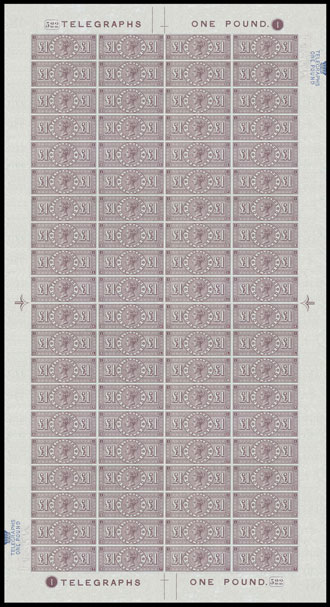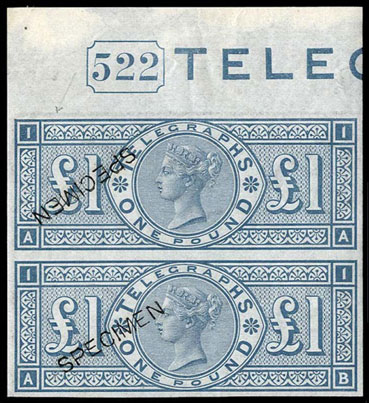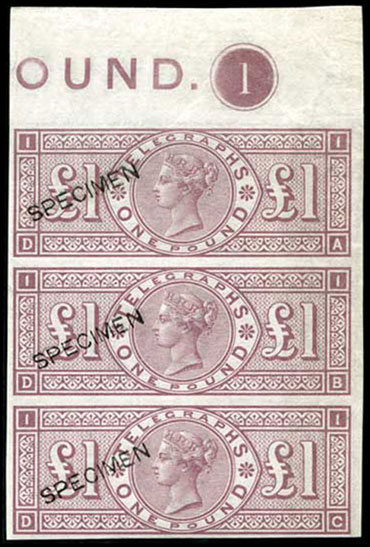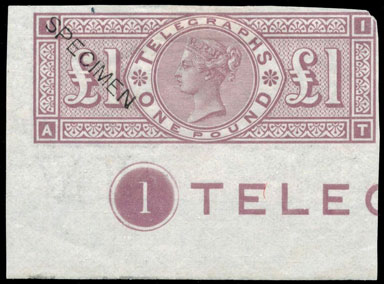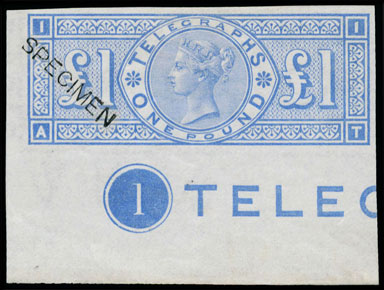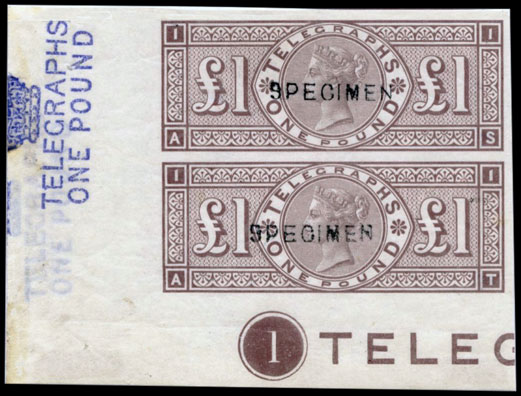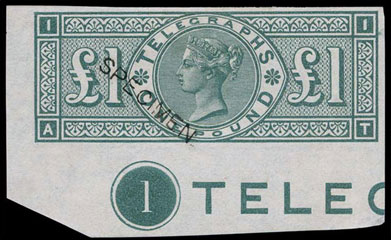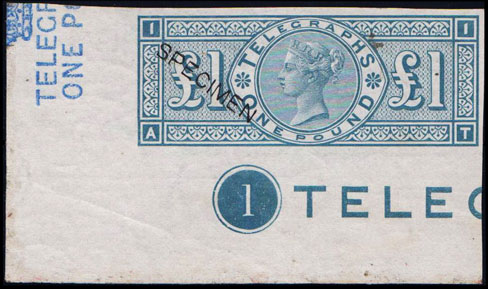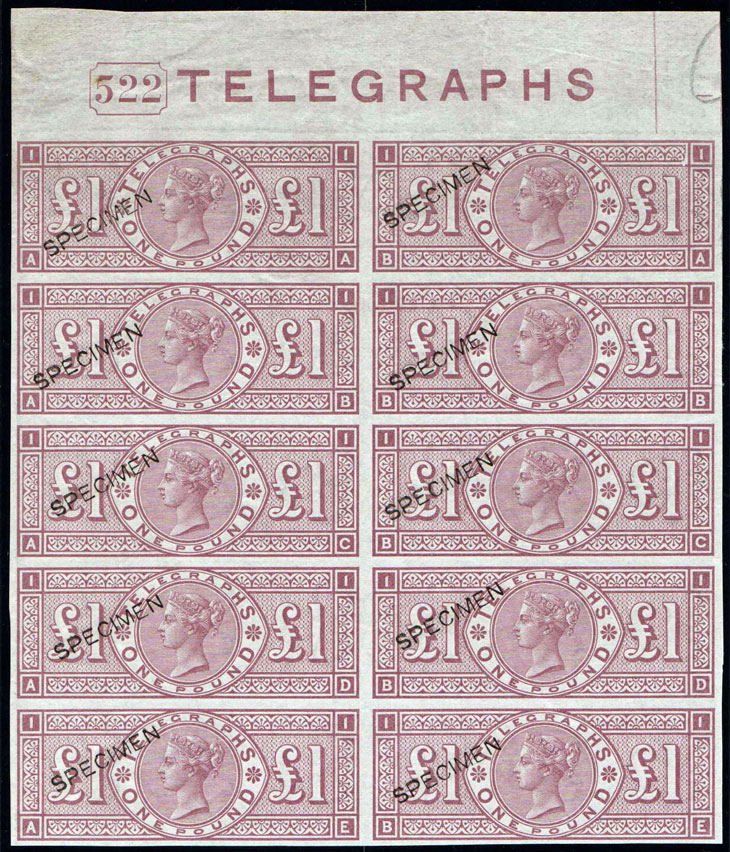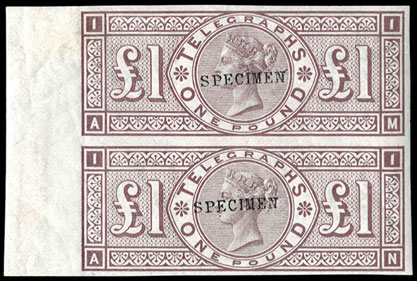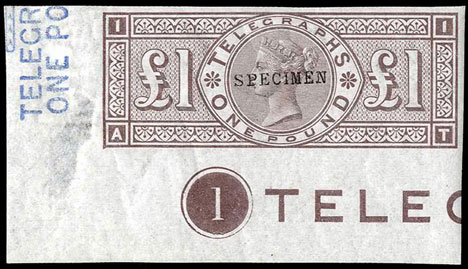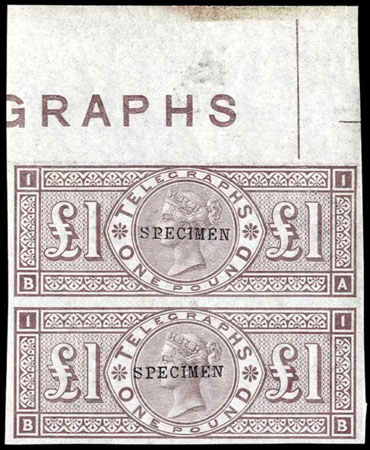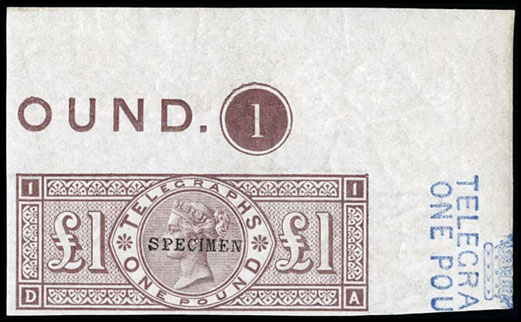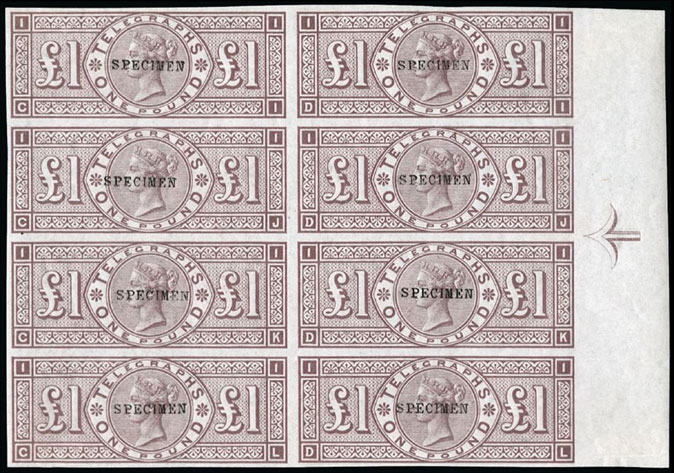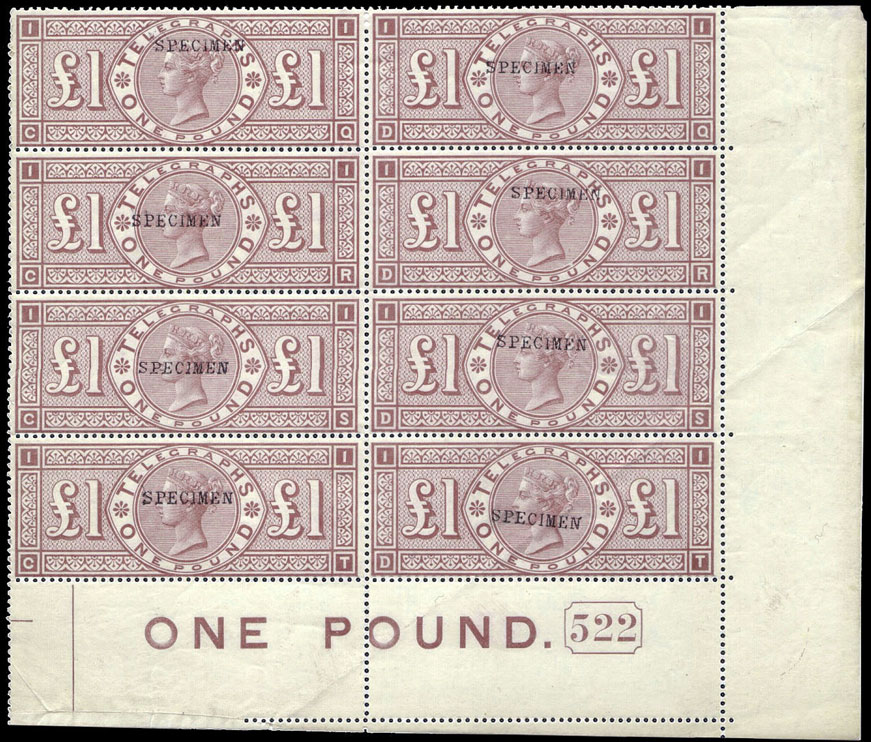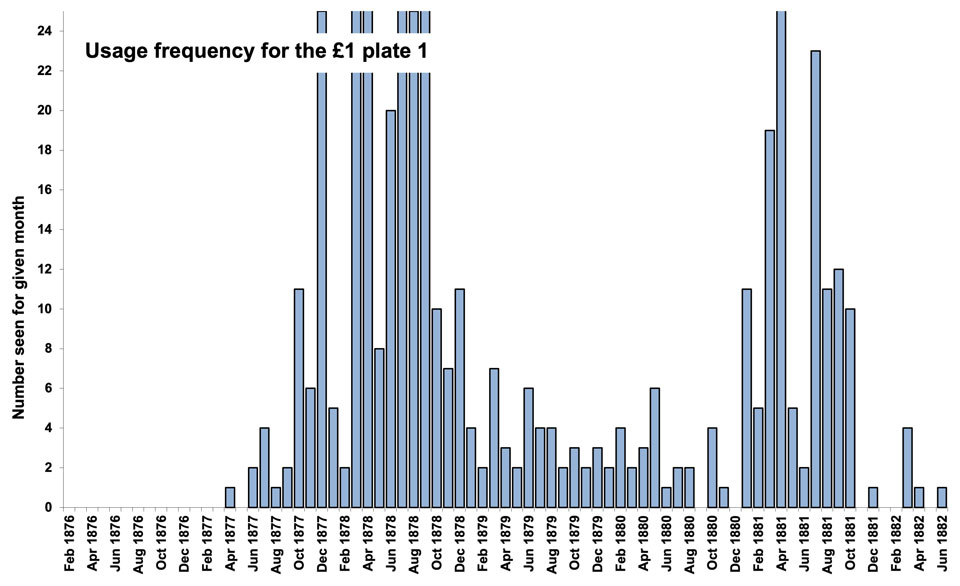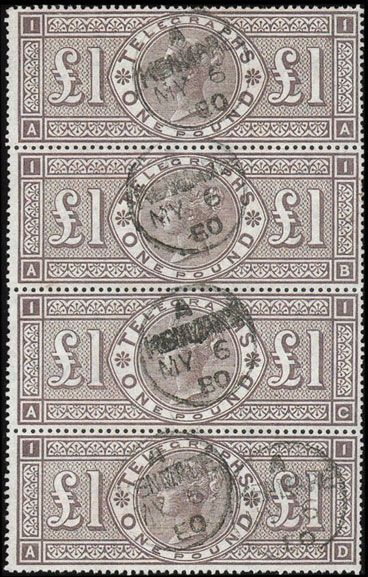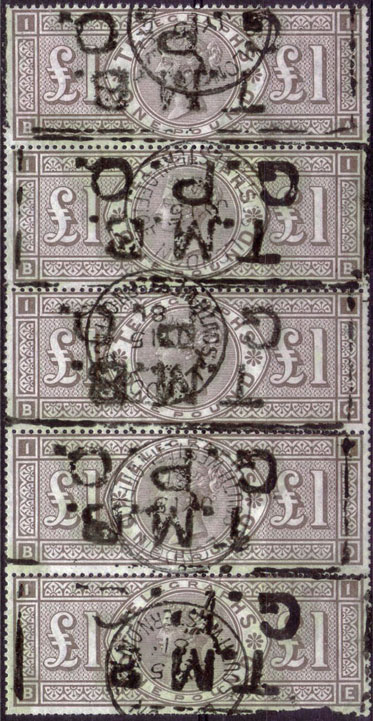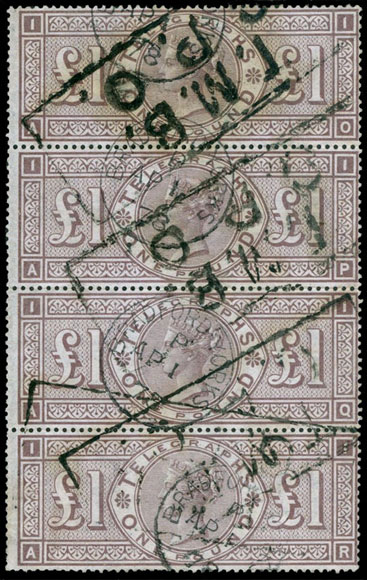1 Essays
2 Die Proofs
3 Sheet Layout
4 Plate Proofs
5 Paper
6 Colour Trials
7 Imprimaturs
8 Colour Standards
9 Specimens
10 Issued Stamps
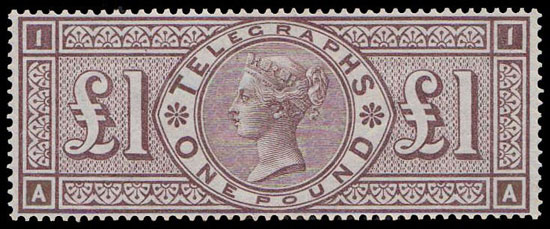
Date: 1 Mar 1877
Plates: 1
Printer: De La Rue
Watermark: Shamrock (sideways)
Perforation: 14
Soon after the first issue of telegraph stamps on 1 Feb 1876 there was a demand for more values. On 24 Mar 1876 the Postmaster General approved six new values: 4d, 6d, 3s, 10s, £1, and £5.
It had been decided that telegraph stamps of the same value as postage stamps would be printed in the same colour and on the same paper as the corresponding postage stamps. However, at the time there was no corresponding £1 postage stamp (first issued in 1878), so Shamrock paper was chosen and trials were produced in six different colours.
Only one plate was prepared and registered.
Essays
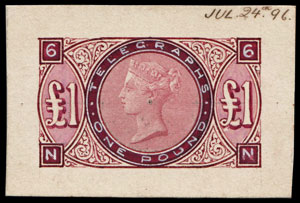
Several essays were prepared by De La Rue for the second issue, including designs lettered ‘C’ to ‘H’ and dated 21 Apr 76. A further design for the £1 is dated “JUL 24 96” (in error for 76). Approved designs of all six values were submitted later but are undated. All except the one illustrated above are now in the Royal Philatelic Collection.
| G | £1 | 66 | NN | violet |
| — | £1 | 66 | NN | dull rose (illustrated) |
| — | £1 | 66 | NN | reddish purple, approved design |
For more details on second issue essays click here.
Die Proofs
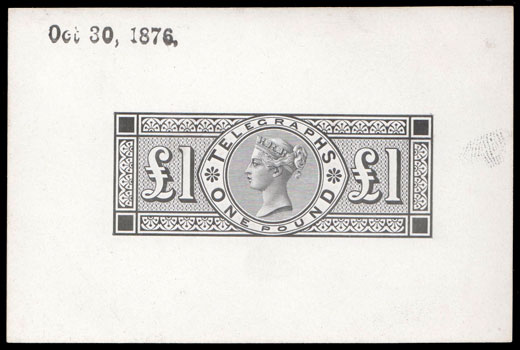
To see more £1 Die Proofs click here.
| Oct 20, 1876 | — | — | — | 0 |
| Oct 23, 1876 | — | — | — | 0 |
| Oct 26, 1876 | — | — | — | 0 + 1 |
| Oct 26, 1876 | — | — | Dated “26-10” in pencil | 1 |
| Oct 27, 1876 | — | — | — | 3 + 1 |
| Oct 28, 1876 | — | — | — | 4 |
| Oct 30, 1876 | — | — | — | 5 + 1 |
| Oct 31, 1876 | — | — | “BEFORE HARDENING” | 2 |
| Nov 2, 1876 | — | — | “BEFORE HARDENING” | 5 + 1 |
| Nov 10, 1876 | — | — | “AFTER HARDENING”, “NG” | 0 + 1 |
| no date | — | — | Basic Die Proof | 0 + 1 |
| no date | — | — | Cut down to stamp size | 1 |
From the Striking Books
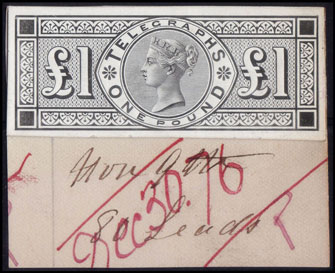
| Nov 9, 1876 | — | — | “Nov 9 / 80 Leads”, “Dec 30.76 / P” | 1 |
In a Countersunk Frame
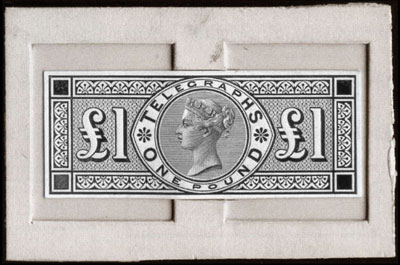
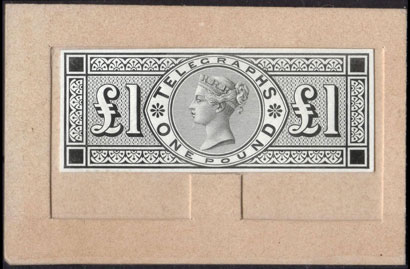
| no date | — | — | Cut down, set in a countersunk frame | 2 |
Sheet Layout
The sheet had 80 stamps in one large pane, arranged as 20 rows of four. Above and below the pane was “TELEGRAPHS ONE POUND.”. Plate numbers were above DA and below AT, current numbers above AA and below DT. At the middle of the top and bottom was a cross and a vertical line used as guides for perforating. At the middle of each side was an arrow shaped division ornament.
10 shillings and above could be supplied singly to postmasters, there were no Post Office sheets.
Computer generated image, click to enlarge.
Plate Proofs
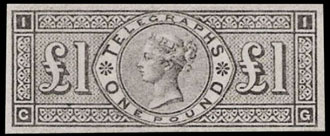
No plate proofs are recorded for this value. However, an illustration in Wright and Creeke shows an imperforate example lettered CG, although it is equally likely to be an imprimatur.
Paper
De La Rue used the paper they had in use for Irish dog license stamps, but this time in a vertical format. The £1 was printed on sheets rotated anticlockwise, each stamp having three sideways shamrocks.
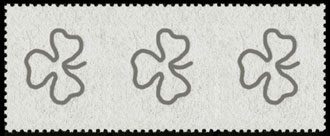
The watermark as seen from the front of the stamp.
For more details on Shamrock paper click here.
Colour Trials
For the second issue, colour trials were taken for all six values. They were dated “15 DEC 76”. The £1 was printed in six different colours, one sheet of each, with a letter “A” through “F” written in the sheet margin next to the datestamp, below CT. Other blocks have had letters added, presumably after they were cut from the sheet.
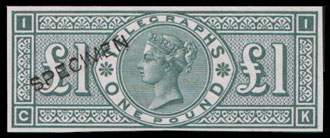
A: Grey-green
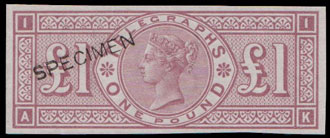
C: Dull Claret
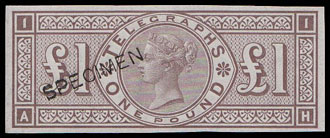
E: Brown-lilac
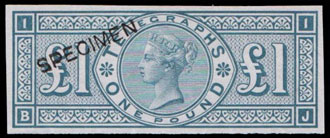
B: Slate-blue
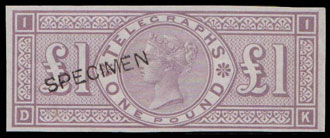
D: Dull Mauve
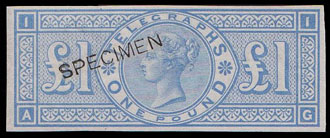
F: Pale Ultramarine
All are overprinted with Specimen Type 8 (top 15 rows diagonal up, bottom 5 rows diagonal down), except for the selected colour (E: Brown-lilac) which has three types of Specimen overprint all from the same sheet.
A: Grey-green

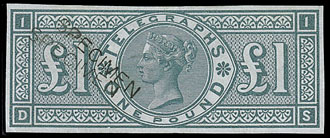
DS has a double overprint.
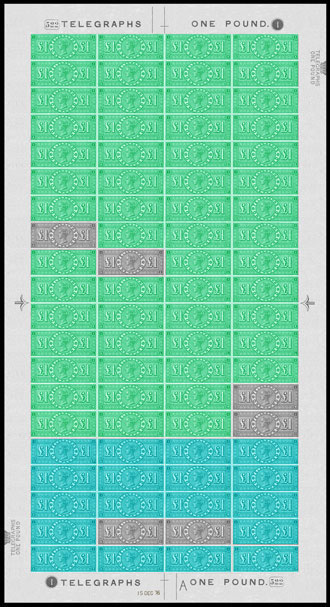
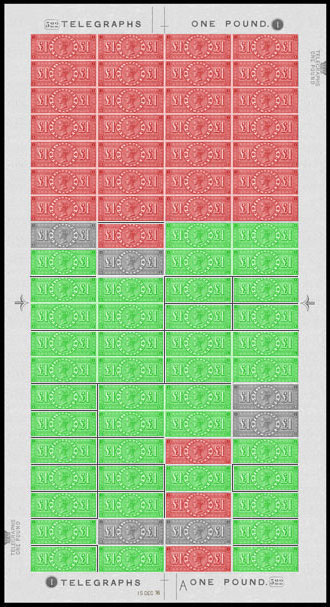
CP is in the Royal Philatelic Collection, CR in the Tapling Collection, CT in the Phillips Collection.
Five blocks of 4 still exist, with two other blocks recently split into singles.
B: Slate-blue

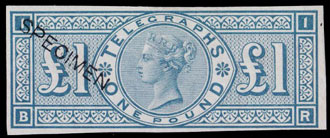
AA has the overprint inverted.
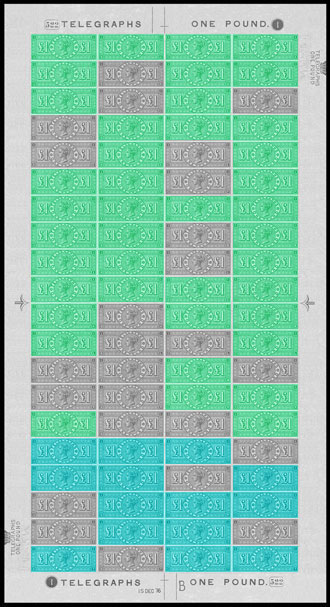
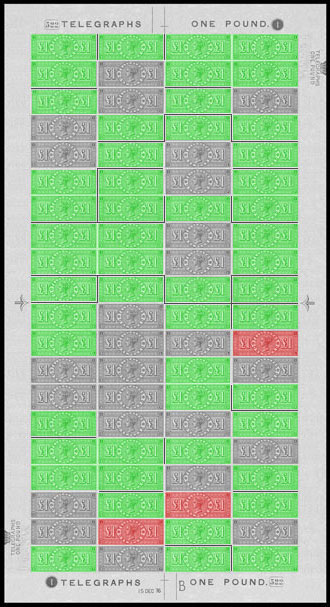
Three blocks of 4 and several pairs still exist.
C: Dull Claret

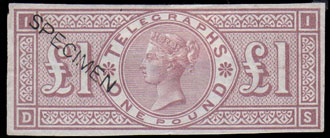
CC has a double overprint.
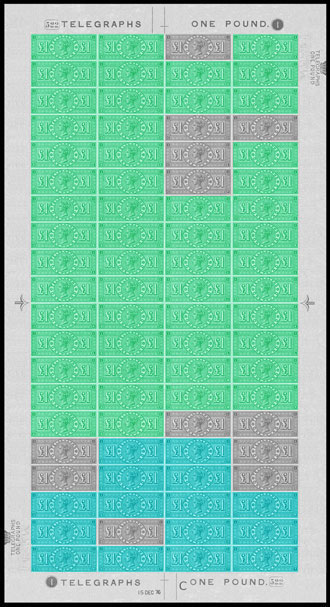
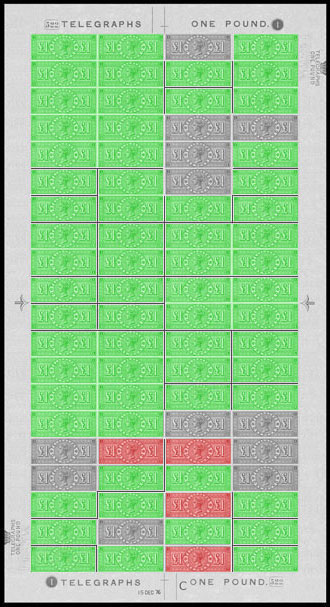
CR in the Tapling Collection, CP in the Phillips Collection.
Blocks of 10 & 8, two blocks of 4, a strip of 3, and several pairs still exist.
D: Dull Mauve

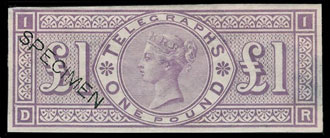
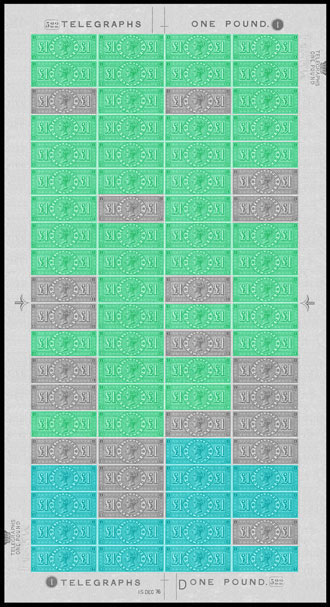
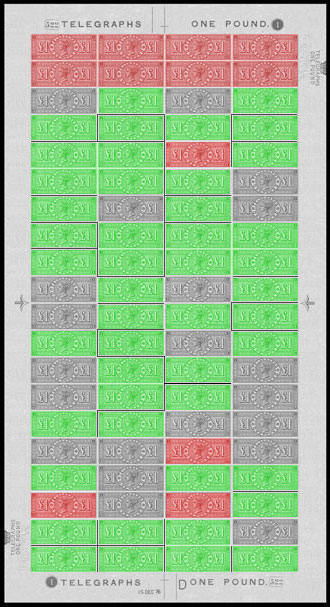
CP is in the Royal Philatelic Collection, CR in the Tapling Collection, AR in the Phillips Collection.
A block of 8 and two blocks of 4 still exist. A pair CS-CT has manuscript “D”.
E: Brown-lilac (Selected Colour)

Type 8 diagonal up
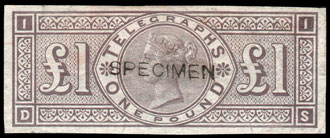
Type 8 horizontal
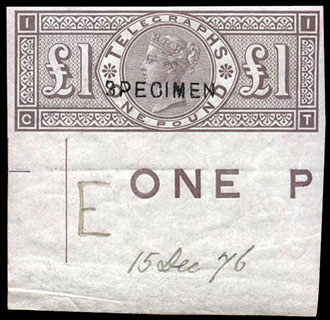
Type 11 horizontal
| Type 8: | Diag Down | Horizontal | Diag Up |
| Type 11: | Diag Down | Horizontal | Diag Up |
Green a known example in private hands.
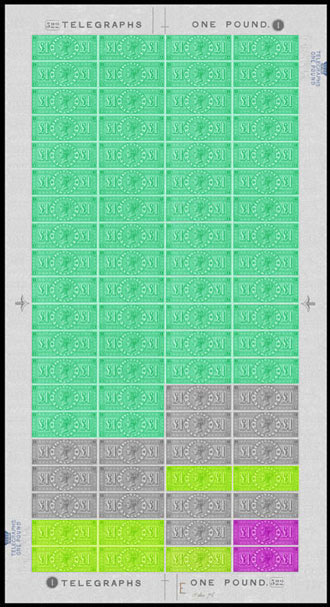
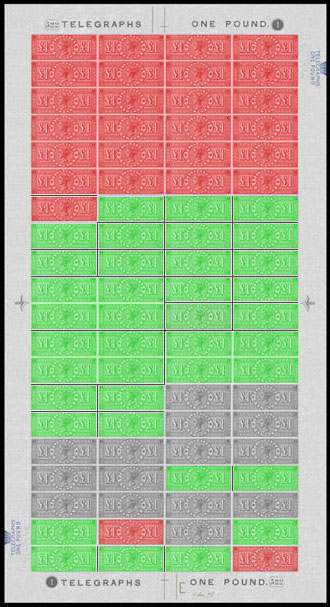
CT has manuscript “E” and manuscript “15 Dec 76”.
Three blocks of 4 still exist in addition to the block of 24.
F: Pale Ultramarine

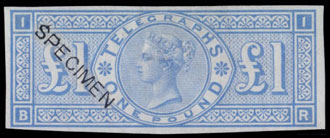
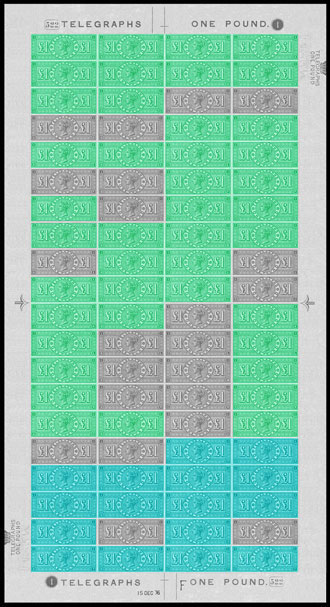
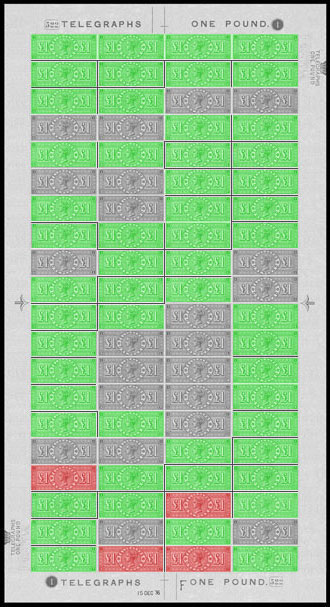
CR in the Tapling Collection, CT in the Phillips Collection with manuscript “F”.
Colour Trial Images
Click the images to enlarge.
Imprimaturs
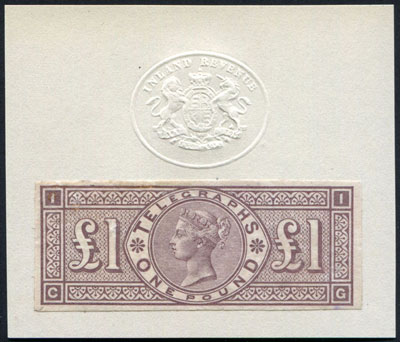
Plate 1 was registered on 12 Jan 1877.
Some imprimaturs have been perforated to look like mint stamps, sometimes poorly, often expertly. There are thus fewer imprimaturs known than expected, and more mint stamps known than expected. Mint stamps should be viewed with suspicion if from the imprimatur positions of the sheet.
The perforations on the stamp below are not right, especially at the corners. It’s likely an imprimatur.
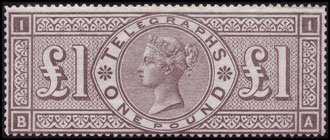
The registration sheets for the Telegraphs have been lost. We can reconstruct them from known examples; however, the pattern that emerges for the high values is not as clear as that for the low values.
The low values generally have a column of 12 taken, plus four from the adjacent column, and a plate number example from the opposite corner. One sheet of each value has an extra column of 12 taken. The £1 fits this pattern if the first “column” of 12 is the top three rows, the extra 12 are the next three rows, the adjacent four are the 7th row, and the opposite corner is the bottom corner.
Red represents an institutionalised example.
Green a known example in private hands.
Blue is unknown but predicted by the pattern.
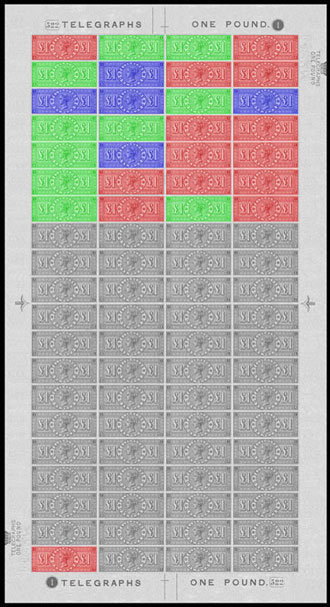
| Institutionalised/Total: | 14/29 |
| Royal Philatelic Collection: | AT, CF-DF, DA |
| British Postal Museum: | BG, DG |
| Tapling Collection: | CB |
| Langmead Collection: | AA, CD-DE |
| Phillips Collection: | BF, DB |
Two pairs remain intact: AD-AE and CF-DF.
One block of four remains intact: CD-DE.
CG is listed as OG in Langmead and Huggins.
Colour Standards
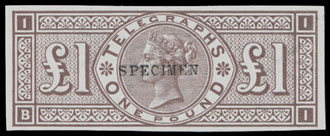
One complete sheet came on to the market in the 1930s: plate 1, imperforate, overprinted Specimen Type 9 horizontally. The stamps are mostly in blocks of four, with one block of eight.
Red represents an institutionalised example.
Green a known example in private hands.
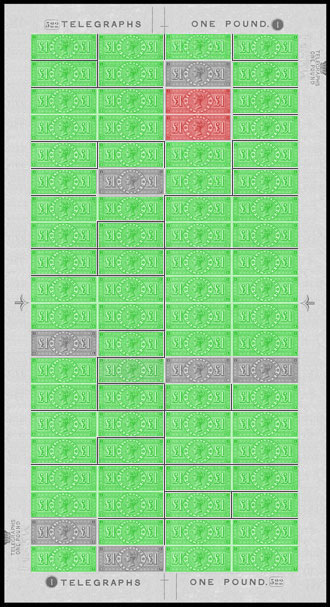
Pair CC-CD is in the Langmead Collection.
Click the images to enlarge.
Specimens
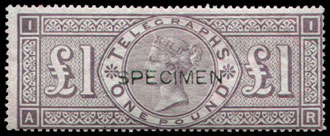
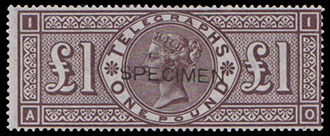
Plate 1 Type 8: scarce, from 3 quarter sheets (AK-BT x3), all singles, 29 known.
Plate 1 Type 8: also known in Deep Brown-lilac, from 1 quarter sheet.
An example in the Langmead Collection exists with both Specimen Type 8 and Type 9.
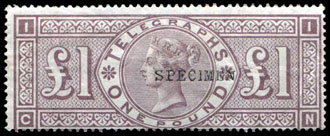
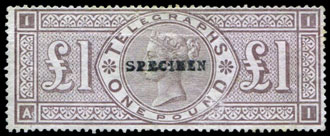
Plate 1 Type 9: common, from 5 quarter sheets (AA-BJ, CK-DT x4), 4 pairs, strip of 3, block of 8, 45 known.
Plate 1 Type 9b: scarce, from 4 quarter sheets (AA-BJ x3, AK-BT), all singles, 15 known.
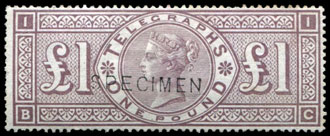
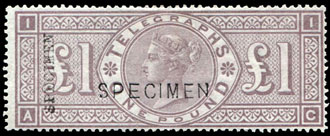
Plate 1 Type 11: scarce, from 3 quarter sheets (AA-BJ x3), all singles, 26 known.
Plate 1 Type 11 and Type 9b: rare, possibly unique.
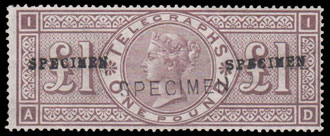
Plate 1 Type 11 and Type 9b twice: rare, possibly unique.
Click the image to enlarge.
Reference to scarcity, blocks and the number of sheets or panes so treated is derived from reconstructions of known examples within our database.
Issued Stamps
Stamps were issued from plate 1 only.
The usage frequency graph shows that plate 1 was used across the whole period of the second issue.
Click the graph to enlarge.
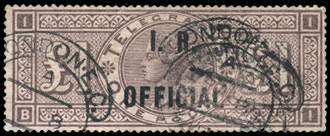
Postal, fiscal, and railway usage are rare, this example is fake.
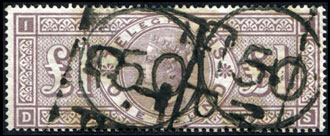
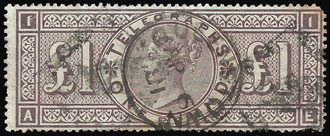
Only 150, 342, and 1442 “English Station” railway numerals are known to us, there are others with unreadable numbers. One “Irish Station” railway numeral is known for Queenstown but the number is unreadable.
Issued Stamps — Plate 1
Plate 1 (current no. 522) was registered on 12 Jan 1877 and put to press on 15 Jan 1877. 5,000 sheets were printed before telegraph stamps were discontinued.
Some imprimaturs have been perforated to look like mint stamps, sometimes poorly, often expertly. There are thus fewer imprimaturs known than expected, and more mint stamps known than expected. Mint stamps should be viewed with suspicion if from the imprimatur positions of the sheet.
Scarcity #30 in mint telegraphs, #10 in used telegraphs.
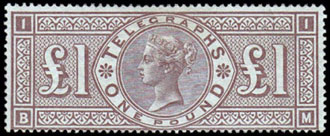
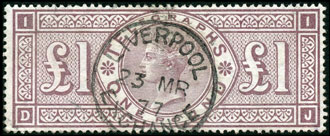
No mint multiples are known to us.
Used stamps are common. Used multiples are less common with four pairs, three strips of 3, four strips of 4, and a strip of 5 in our database. The earliest known used examples are 14 June 1877 at Armagh, Ireland (illustrated) and at Lothbury B.O., E.C.
Inverted watermarks probably exist, but none have been seen by us.
Click the images to enlarge.
